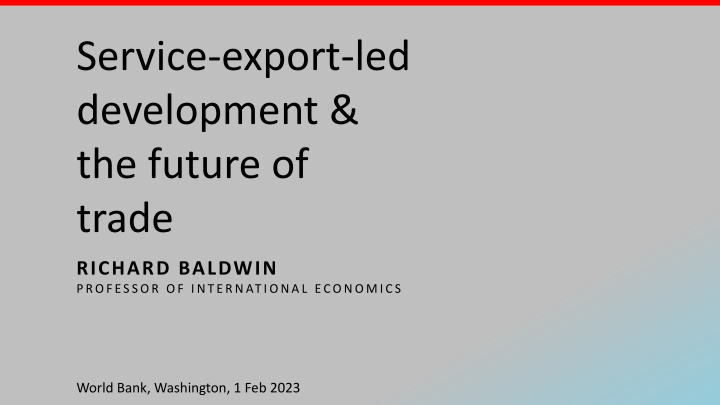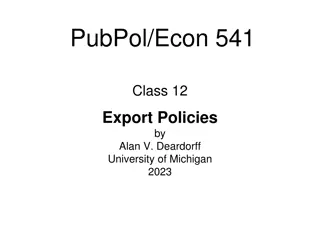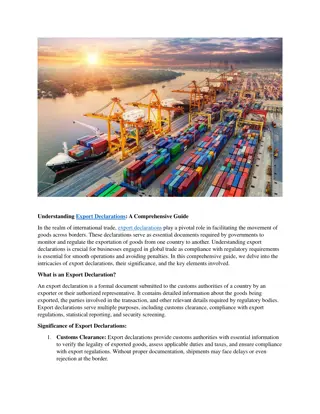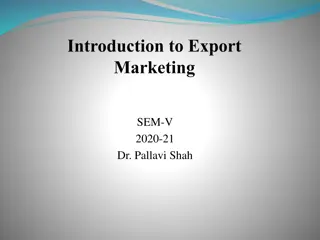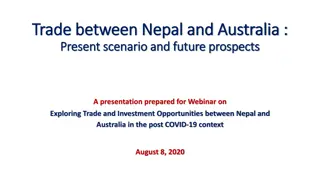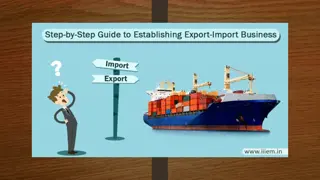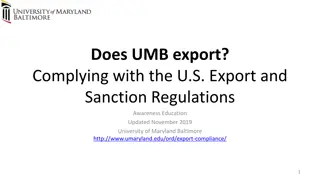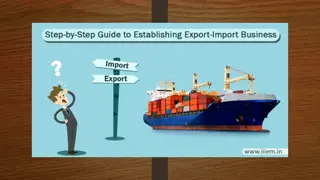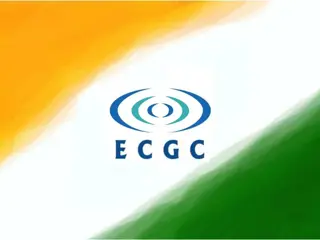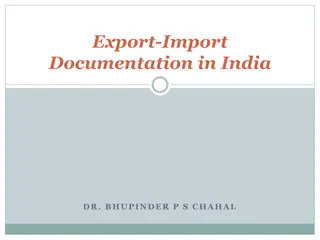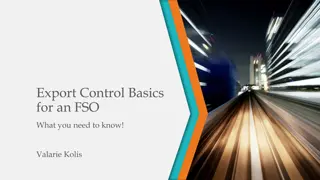Service-Export-Led Development & the Future of Trade Analysis
Shift from manufacturing-export-led pathway to service-export-led pathway, highlighting the closing of the old manufacturing pathway, the expansion of service exports, and the need for new theoretical approaches. Delve into the trends of offshoring phases, changes in supply chains, and the impact on world goods trade to GDP ratios over the years.
Download Presentation

Please find below an Image/Link to download the presentation.
The content on the website is provided AS IS for your information and personal use only. It may not be sold, licensed, or shared on other websites without obtaining consent from the author.If you encounter any issues during the download, it is possible that the publisher has removed the file from their server.
You are allowed to download the files provided on this website for personal or commercial use, subject to the condition that they are used lawfully. All files are the property of their respective owners.
The content on the website is provided AS IS for your information and personal use only. It may not be sold, licensed, or shared on other websites without obtaining consent from the author.
E N D
Presentation Transcript
Service-export-led development & the future of trade RICHARD BALDWIN PROFESSOR OF INTERNATIONAL ECONOMICS World Bank, Washington, 1 Feb 2023
Outline of argument 1.The old manufacturing-export-led pathway is closing or closed 2.The Service-export pathway is open, and widening fast 3.Need for new theory and pragmatic empirical techniques
Old manufacturing pathway is closing or already closed
Offshoring-expansion phase has ended Share of world manufacturing GDP, G7, I6 & Rest of World, 1990 to 2020 2ndUnbundling Manuf offshoring accelerated industrialisation of handful of EMs But transition is almost finished 70% 60% I6, 38% 1999 66% 2014 38% 50% G7 37% 40% 26% 30% 20% RoW 25% I6 10% 35% I6, 10% 0% 2017 1990 I6 is China, India, Korea, Indonesia, Thailand, and Brazil B7 is France, Italy, Germany, UK, Japan, US, and Canada 1993 1996 1999 2002 2005 2008 2011 2014 2020
Supply chains: shorter domestically & internationally Ratio of value of world intermediates to world GDP in manufactures falling since 2013 Evidence of unwinding supply chains Domestically & internationally Intermediates / Value Add (manufacturing), World 2013 250% 240% 2008 230% 2018 220% 210% 200% 1999 190% 180% 170% 2006 2008 2010 1995 1996 1997 1998 1999 2000 2001 2002 2003 2004 2005 2007 2009 2011 2012 2013 2014 2015 2016 2017 2018
World goods trade to GDP peaked World goods trade to GDP peaked in 2008 World exports & imports of goods, 1960-2020 (% of world GDP) 2008, 50% % of world GDP (current US$) 55% 50% 45% 40% 2020 42% 35% 1960 19% 30% 25% 1993 29% 20% 15% 10% 2011 1960 1963 1966 1969 1972 1975 1978 1981 1984 1987 1990 1993 1996 1999 2002 2005 2008 2014 2017 2020 NB: World imports of goods equal world exports of goods
World goods trade to world GDP ratio, by sector, 1980 2020 . World goods trade as % world GDP by sector 1980 - 2020 About 60% of the drop in the trade ratio was due to mining and fuels, Rest by manufactures 60% 2008 50% Total goods 40% 30% Manufactures 20% Mining & Fuels 10% Agricultural goods 0% 1980 1989 1998 2007 2016 1983 1986 1992 1995 2001 2004 2010 2013 2019
Why goods trade ratio falling since 2008? (before Trump/Brexit, Geoec tensions, supply chain issues) Technology: Automation lowers labour cost-share and thus reduces incentives to produce abroad NB:Comparative advantage can t come from freely trade inputs
Bold conjecture #1 -Manufactured goods are becoming nontraded & jobless
The Service-export pathway is open, and widening fast
Tele-migration Definition: People sitting in one nation & working in offices in another Cross-border telework Driving force: Digitech makes it possible Enormous wages gaps make it profitable
Modes of telemigration -Freelancing -BPO/KPO -Call centres -Shared Service Centres
FACT: Intermediate inputs are more important in services imports than manufactures imports
FACT: Service intermediates are 3x more important than manufacturing intermediates in overall economy Sector share of total gross output Column sector's inputs into row sector (gross output) 2018 Service intermediate inputs Manufactures intermediate inputs Service sector Manufacturing sector 32% 24% 5% 25% 68% 26% Total economy 30% 11% 100%
FACT: Trade in other commercial services (OCS) has growth twice as fast as goods trade since 1990, now 20% of all international commerce
#2: 4 facts and a conclusion 1. Barriers to services trade are much higher than barriers to goods trade Most barriers to trade in intermediate services are technology- linked, not policy linked Digitech is lowering barriers to intermediate services at an explosive pace (+ Covid forced adjustment) Demand is huge in rich nations; Capacity is huge in emerging markets ERGO: Intermediate services trade will grow much faster than goods trade for foreseeable future 2. 3. 4.
Argument: Baldwin & Forslid (2019), Globotics and development
Bold conjecture #2 Trade in intermediate services will dominant future trade
Service-led development is happening
Geography is too hard to overcome in manufacturing 2000 kms 2000 kms 3000 kms Factory Europe (20%) Factory N.Amer. (19%) Factory N.E. Asia (38%)
NB: Services are easier 1. Lower scale economies 2. Capacity is less of an issue 3. Geographic distance matters less 4. Big demand in N, big supply in S
1 The Emerging Market miracle will continue and spread but this time based on services
Same comparative advantage: telemigration allows Emerging Markets to export their advantage directly Goods Emerging Markets competitive advantage Exports Factories or Farms Low cost labour
Different structural transformation Service-led development, not manufacturing-led development - Think India, not China - Think Service Value Chains , not GVCs
New Development Strategies Needed Think cities, services, and training Not factories, industrial equipment, and technology
New development theory needed Probably will be an extension of urban growth theory, like Hoyt model
New diagnostics needed Service wage differences in teleworkable sectors adjusted by productivity differences (Productivity = service GDP per worker???)
4 Telemigration will foster a new backlash against globalisation in advanced economies
Horizontal axis is Automatability Score (0 to 1, Median=.503), Vertical axis is Teleworkable Score (0 to 1, Median=.466) globotics quadrant 1.0 General clerical workers,6.3m, 0.9 0.8 0.7 Teachers, 5.4 0.6 Accountancy clerks, 5.2 Susceptibility by occupation x-axis = automation y-axis = globalisation 0.5 Sales workers, 8m 0.4 Carrying, cleaning, packaging, and related workers, 7.6m 0.3 Public health nurses, midwives, and nurses,6.6m 0.2 0.1 Offshor- ability Food and drink cooking, staff serving customers, 10.6m 0.0 0.0 0.1 0.2 0.3 0.4 0.5 0.6 0.7 0.8 0.9 1.0 Workers in Family Life Support and Care Service,7.2m Manufacturing process workers, 8.5m Automatability Million jobs per quadrant: NW = 57, NE = 11, SW = 16, SE = 20
Fact: Service trade growing faster than goods Telemigration services growing 2-3 times faster
Commodity super cycle & manuf & mining World goods trade prices, 1950-2020 Prices of all 3 categories of goods fell from 2010, or so Until recently 200 2011 180 160 Fuels & mining 140 120 Manufactures 100 80 Agricultural 60 40 20 1990 1998 0 1958 1986 2014 1950 1954 1962 1966 1970 1974 1978 1982 1990 1994 1998 2002 2006 2010 2018 Note: Import unit value chained indices - annual, stats.wto.org , 2015 = 100
2008 is a false peak: 2008 is a false peak: National ratios peaked before or after or not China peaked 2006 US peaked 2011 Japan peaked 2014 EU has stagnated not peaked (mixed trends) Pre- and post-2008 peaks Imports + exports of goods as % of GDP (2008 = 100) China, 2006 120 Japan, 2014 US, 2011 100 EU Japan 80 US 60 China 40 2005 2009 1993 1994 1995 1996 1997 1998 1999 2000 2001 2002 2003 2004 2006 2007 2008 2010 2011 2012 2013 2014 2015 2016 2017 2018 2019 2020
China is converging to openness of a normal China is converging to openness of a normal mega mega- -economy economy Mega economies are rather closed (trade/GDP) China is normalising Imports + exports of goods as % of GDP 70% 60% China 50% 40% EU (external trade) 30% 20% Japan US 10% 0% 2005 2009 2013 2000 2001 2002 2003 2004 2006 2007 2008 2010 2011 2012 2014 2015 2016 2017 2018 2019 2020
nChinas very asymmetric engagement with global value chains What is unusual is China s asymmetric engagement in Global Supply Chains Growing on sales side Shrinking on sourcing side China's engagement with GVCs, 1995 - 2018 Intermediates as % of world gross outut China selling intermediates to world 3% 2% China buying intermediates from world 1% 0% 2009 1995 1996 1997 1998 1999 2000 2001 2002 2003 2004 2005 2006 2007 2008 2010 2011 2012 2013 2014 2015 2016 2017 2018 Source: Baldwin, Freeman, Theodorakopoulos (2022).
Getting real Goods trade isn t falling; GDP rising faster Logs of world real GDP & real exports 1972-2021 Real exports to real GDP ratio (2015=100%) 2008 103% 14 2.3 110% 13.9 2.1 100% 13.8 1.9 90% 13.7 2021, 99% 13.6 1.7 80% Log real GDP 13.5 1.5 70% 13.4 Log real exports (left scale) 1.3 60% 13.3 13.2 1.1 50% 2002 1972 1977 1982 1987 1992 1997 2007 2012 2017 1972 1977 1982 1987 1992 1997 2002 2007 2012 2017
Wage gap: How competitive would Colombian workers be in US? ISCO Title Wage ratio Managers Professionals Technicians and associate professionals Clerks Service workers and shop and market sales workers Craft and related trades workers Primary industries Weighted average (ISCO 1D level) Median 14.6 9.4 13.9 11.8 12.9 12.6 11.6 11.8 17.6 Source: Baldwin, Cardenas, and Fernandez (2021)
How digitech makes it possible: Domestic remote work Freelancing platforms Advanced telecomms Machine translation Unbundles service value chain (next)
Point #2: 4 facts and a conclusion 1. Barriers to services trade are much higher than barriers to goods trade Most barriers to trade in intermediate services are technology- linked, not policy linked Digitech is lowering barriers to intermediate services at an explosive pace (+ Covid forced adjustment) Demand is huge in rich nations; Capacity is huge in emerging markets ERGO: Intermediate services trade will grow much faster than goods trade for foreseeable future 2. 3. 4.
What are intermediate services? All the service tasks done in service sector, manufacturing sector, and primary sector that are not sold directly to customers. For example: tasks done by occupations like bookkeepers, forensic accountants, CV screeners, administrative assistants, online client help staff, graphic designers, copyeditors, personal assistants, corporate travel agents, software engineers, lawyers checking contracts, financial analysts writing reports, etc.
Traditional versus digitally enabled services World services trade by major category (% of GDP) 1980-2020 8% Other commerce services 7% 2008 6% 5% 4% 2019 2008 3% Transports services 2% 1% Travel services 0% 1992 2002 2012 1980 1982 1984 1986 1988 1990 1994 1996 1998 2000 2004 2006 2008 2010 2014 2016 2018 2020
Every sector uses service intermediates Service intermediates as share of sector's output Other services 38% Land transport and transport via pipelines 39% IT and other information services 35% Accommodation and food service activities 25% Education 12% Administrative and support services 33% Public administration and defence; compulsory 16% Financial and insurance activities 58% Human health and social work activities 16% Real estate activities 13% Professional, scientific and technical activities 44% Wholesale and retail trade; repair of motor 41% Other secondary 27% Motor vehicles, trailers and semi-trailers 29% Chemical and chemical products 29% Manufacturing nec; repair and installation of 21% Other transport equipment 24% Electricity, gas, steam and air conditioning supply 12% Construction 21% Other primary 29% Food products, beverages and tobacco 32% Agriculture, hunting, forestry 20% 0% 10% 20% 30% 40% 50% 60% 70%
Breaking down the commodity super cycle into prices & volumes
